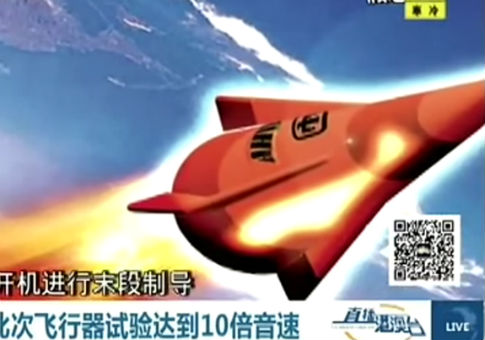OMAHA—China and Russia are developing maneuvering high-speed strike vehicles that pose new threats to the United States, U.S. Strategic Command leaders said Wednesday.
Adm. Cecil D. Haney, Strategic Command’s (Stratcom) senior leader, said during remarks at a nuclear deterrence conference that despite arms control efforts, hypersonic weapons are among several threatening strategic trends emerging in the world.
China has conducted four flight tests of a 7,000 mile-per-hour maneuvering strike vehicle, and Russia is developing high-speed weapons and reportedly tested a hypersonic weapon in February.
"Nation states continue to develop and modernize their nuclear weapon capabilities," Haney said. "Nuclear and non-nuclear nations are prepared to employ cyber, counter-space, and asymmetric capabilities as options for achieving their objectives during crisis and conflict, and new technologies such as hypersonic glide vehicles are being developed, complicating our sensing and defensive approaches."
The advanced weapons capabilities are being proliferated by U.S. adversaries and "are becoming increasingly mobile, hardened, and underground, which is further compounded by a lack of transparency," the four-star admiral said.
Asked later about the hypersonic missile threat, Haney said the Pentagon is developing capabilities that can be used to counter hypersonic arms.
"As I look at that threat, clearly the mobility, the flight profile, those kinds of things are things we have to keep in mind and be able to address across that full kill chain," Haney said.
"Kill chain" is military jargon for the process used to find targets, gauge location and speed, communicate data to weapons used to strike the target, and then launch an attack.
Stratcom is in charge of U.S. nuclear weapons and warfighting, and is tasked with protecting and countering threats to strategic space systems and cyberspace, which is used for command and control of both conventional and nuclear weapons.
Hypersonic weapons are ultra-high speed weapons launched atop missiles that accelerate to speeds of between Mach 5 and Mach 10—five and ten times the speed of sound. The vehicles fly along the edge of space and can glide and maneuver to targets.
Air Force Lt. Gen. James Kowalski, the outgoing deputy commander at Stratcom, said hypersonic strike vehicles are part of efforts by nations to gain strategic advantage.
Hypersonic weapons technology "certainly offers a number of advantages to a state," Kowalski said.
"It offers a number of different ways to overcome defenses, whether those are conventional, or if someone would decide to use a nuclear warhead, I think gives it an even more complicated dimension," Kowalski added.
The three-star general said, "at this point since nothing is fielded it remains something that concerns us and may be an area of discussion in the future."
Hypersonic weapons are being developed by China and Russia to defeat U.S. strategic missile defenses that currently are designed to counter non-maneuvering ballistic missile warheads that travel in more predictable flight paths that are tracked by sensors and can be hit by missile interceptors.
The National Air and Space Intelligence Center has testified to Congress that China’s hypersonic glide vehicle will be used to deliver nuclear weapons. A variant also could be used as part of China’s conventionally-armed anti-ship ballistic missile system, which is aimed at sinking U.S. aircraft carriers far from Chinese shores.
Russian officials have said their hypersonic arms development is aimed to penetrate U.S. missile defenses.
China has conducted four tests of what the Pentagon calls a Wu-14 hypersonic glide vehicle. The four tests over the past several years are an indication the program is a high priority for Beijing.
The Pentagon is also developing hypersonic vehicles, both gliders and "scramjet" powered weapons. A year ago, an Army test of a hypersonic weapon blew up shortly after launch from Kodiak Island, Alaska.
Haney said some of his concerns are being reduced by U.S. weapons research.
"I am assured in some regards because we ourselves are doing some research and development associated with understanding that kind of capability," Haney said.
"But at the same time, clearly, we are working to ensure that we can do what we always do with any threat—be able to understand it and then be able to have a variety of courses of action in order to address it, number one, to deter its use, but then of course to be able to have our own mechanisms to counter that kind of capability."
Haney said it is "very important that we pay attention to that kind of capability."
Nuclear deterrence, preventing foreign nuclear weapons states from attacking, requires more than warheads and bombs on aircraft and missiles, Haney said.
"To have a credible, safe, secure, and effective nuclear deterrent, we must also ensure we have the appropriate intelligence and sensing capabilities to give us those early indications and warnings of threats coming against the U.S. and our Allies including—but not limited to—missile launches and bomber threats," he said. "We must also maintain the ability to communicate and provide the president options should deterrence fail."
As a result, Stratcom also must protect space assets and cyberspace in a conflict, he added.
"Peacetime activities must shape the environment of crisis and conflict and dissuade our adversaries from considering the use of cyber, space, or nuclear in a strategic attack," Haney said.
Kowalski, the deputy commander, also was asked in a meeting with reporters about China’s development of multi-warhead missiles and whether the deployment of additional weapons will change the U.S. nuclear force posture.
"I’m not aware that there’s been any significant change in the overall size of the Chinese [nuclear] inventory that may cause us to go back and reassess," Kowalski said.
"Right now we’re pretty comfortable that they’re well below 300 [warheads] and there’s a mix in there," he said, adding that intelligence estimates of the Chinese arsenal are deficient and that there is a need for greater openness on the part of the Chinese.
